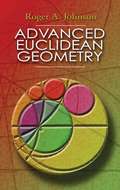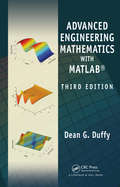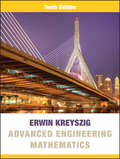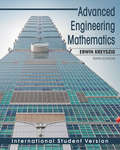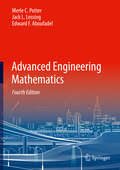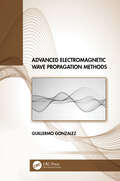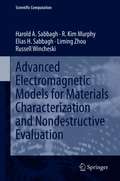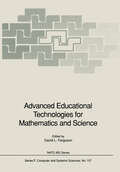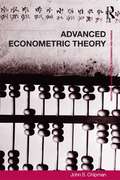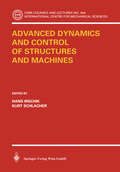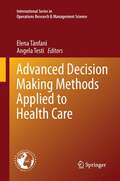- Table View
- List View
Advanced Euclidean Geometry
by Roger A. JohnsonFor many years, this elementary treatise on advanced Euclidean geometry has been the standard textbook in this area of classical mathematics; no other book has covered the subject quite as well. It explores the geometry of the triangle and the circle, concentrating on extensions of Euclidean theory, and examining in detail many relatively recent theorems. Several hundred theorems and corollaries are formulated and proved completely; numerous others remain unproved, to be used by students as exercises.The author makes liberal use of circular inversion, the theory of pole and polar, and many other modern and powerful geometrical tools throughout the book. In particular, the method of "directed angles" offers not only a powerful method of proof but also furnishes the shortest and most elegant form of statement for several common theorems. This accessible text requires no more extensive preparation than high school geometry and trigonometry.
Advanced Engineering Mathematics with Modeling Applications
by S. Graham KellyEngineers require a solid knowledge of the relationship between engineering applications and underlying mathematical theory. However, most books do not present sufficient theory, or they do not fully explain its importance and relevance in understanding those applications.Advanced Engineering Mathematics with Modeling Applications employs a balance
Advanced Engineering Mathematics with MATLAB (Advances in Applied Mathematics)
by Dean G. DuffyAdvanced Engineering Mathematics with MATLAB, Fourth Edition builds upon three successful previous editions. It is written for today’s STEM (science, technology, engineering, and mathematics) student. Three assumptions under lie its structure: (1) All students need a firm grasp of the traditional disciplines of ordinary and partial differential equations, vector calculus and linear algebra. (2) The modern student must have a strong foundation in transform methods because they provide the mathematical basis for electrical and communication studies. (3) The biological revolution requires an understanding of stochastic (random) processes. The chapter on Complex Variables, positioned as the first chapter in previous editions, is now moved to Chapter 10. The author employs MATLAB to reinforce concepts and solve problems that require heavy computation. Along with several updates and changes from the third edition, the text continues to evolve to meet the needs of today’s instructors and students.
Advanced Engineering Mathematics with MATLAB (Advances In Applied Mathematics Ser.)
by Dean G. DuffyTaking a practical approach to the subject, Advanced Engineering Mathematics with MATLAB, Third Edition continues to integrate technology into the conventional topics of engineering mathematics. The author employs MATLAB to reinforce concepts and solve problems that require heavy computation. MATLAB scripts are available for download at www.crcpres
Advanced Engineering Mathematics with MATLAB (Advances in Applied Mathematics)
by Dean G. DuffyIn the four previous editions the author presented a text firmly grounded in the mathematics that engineers and scientists must understand and know how to use. Tapping into decades of teaching at the US Navy Academy and the US Military Academy and serving for twenty-five years at (NASA) Goddard Space Flight, he combines a teaching and practical experience that is rare among authors of advanced engineering mathematics books. This edition offers a smaller, easier to read, and useful version of this classic textbook. While competing textbooks continue to grow, the book presents a slimmer, more concise option. Instructors and students alike are rejecting the encyclopedic tome with its higher and higher price aimed at undergraduates. To assist in the choice of topics included in this new edition, the author reviewed the syllabi of various engineering mathematics courses that are taught at a wide variety of schools. Due to time constraints an instructor can select perhaps three to four topics from the book, the most likely being ordinary differential equations, Laplace transforms, Fourier series and separation of variables to solve the wave, heat, or Laplace's equation. Laplace transforms are occasionally replaced by linear algebra or vector calculus. Sturm-Liouville problem and special functions (Legendre and Bessel functions) are included for completeness. Topics such as z-transforms and complex variables are now offered in a companion book, Advanced Engineering Mathematics: A Second Course by the same author. MATLAB is still employed to reinforce the concepts that are taught. Of course, this Edition continues to offer a wealth of examples and applications from the scientific and engineering literature, a highlight of previous editions. Worked solutions are given in the back of the book.
Advanced Engineering Mathematics with MATLAB (Advances in Applied Mathematics)
by Dean G. DuffyIn the four previous editions the author presented a text firmly grounded in the mathematics that engineers and scientists must understand and know how to use. Tapping into decades of teaching at the US Navy Academy and the US Military Academy and serving for twenty-five years at (NASA) Goddard Space Flight, he combines a teaching and practical experience that is rare among authors of advanced engineering mathematics books. This edition offers a smaller, easier to read, and useful version of this classic textbook. While competing textbooks continue to grow, the book presents a slimmer, more concise option. Instructors and students alike are rejecting the encyclopedic tome with its higher and higher price aimed at undergraduates. To assist in the choice of topics included in this new edition, the author reviewed the syllabi of various engineering mathematics courses that are taught at a wide variety of schools. Due to time constraints an instructor can select perhaps three to four topics from the book, the most likely being ordinary differential equations, Laplace transforms, Fourier series and separation of variables to solve the wave, heat, or Laplace's equation. Laplace transforms are occasionally replaced by linear algebra or vector calculus. Sturm-Liouville problem and special functions (Legendre and Bessel functions) are included for completeness. Topics such as z-transforms and complex variables are now offered in a companion book, Advanced Engineering Mathematics: A Second Course by the same author. MATLAB is still employed to reinforce the concepts that are taught. Of course, this Edition continues to offer a wealth of examples and applications from the scientific and engineering literature, a highlight of previous editions. Worked solutions are given in the back of the book.
Advanced Engineering Mathematics with Mathematica
by Edward B. MagrabAdvanced Engineering Mathematics with Mathematica® presents advanced analytical solution methods that are used to solve boundary-value problems in engineering and integrates these methods with Mathematica® procedures. It emphasizes the Sturm–Liouville system and the generation and application of orthogonal functions, which are used by the separation of variables method to solve partial differential equations. It introduces the relevant aspects of complex variables, matrices and determinants, Fourier series and transforms, solution techniques for ordinary differential equations, the Laplace transform, and procedures to make ordinary and partial differential equations used in engineering non-dimensional. To show the diverse applications of the material, numerous and widely varied solved boundary value problems are presented.
Advanced Engineering Mathematics with Mathematica
by Edward B. MagrabAdvanced Engineering Mathematics with Mathematica® presents advanced analytical solution methods that are used to solve boundary-value problems in engineering and integrates these methods with Mathematica® procedures. It emphasizes the Sturm–Liouville system and the generation and application of orthogonal functions, which are used by the separation of variables method to solve partial differential equations. It introduces the relevant aspects of complex variables, matrices and determinants, Fourier series and transforms, solution techniques for ordinary differential equations, the Laplace transform, and procedures to make ordinary and partial differential equations used in engineering non-dimensional. To show the diverse applications of the material, numerous and widely varied solved boundary value problems are presented.
Advanced Engineering Mathematics: A Second Course with MatLab (Advances in Applied Mathematics)
by Dean G. DuffyThrough four previous editions of Advanced Engineering Mathematics with MATLAB, the author presented a wide variety of topics needed by today's engineers. The fifth edition of that book, available now, has been broken into two parts: topics currently needed in mathematics courses and a new stand-alone volume presenting topics not often included in these courses and consequently unknown to engineering students and many professionals. The overall structure of this new book consists of two parts: transform methods and random processes. Built upon a foundation of applied complex variables, the first part covers advanced transform methods, as well as z-transforms and Hilbert transforms--transforms of particular interest to systems, communication, and electrical engineers. This portion concludes with Green's function, a powerful method of analyzing systems. The second portion presents random processes--processes that more accurately model physical and biological engineering. Of particular interest is the inclusion of stochastic calculus. The author continues to offer a wealth of examples and applications from the scientific and engineering literature, a highlight of his previous books. As before, theory is presented first, then examples, and then drill problems. Answers are given in the back of the book. This book is all about the future: The purpose of this book is not only to educate the present generation of engineers but also the next. "The main strength is the text is written from an engineering perspective. The majority of my students are engineers. The physical examples are related to problems of interest to the engineering students." --Lea Jenkins, Clemson University
Advanced Engineering Mathematics: A Second Course with MatLab (Advances in Applied Mathematics)
by Dean G. DuffyThrough four previous editions of Advanced Engineering Mathematics with MATLAB, the author presented a wide variety of topics needed by today's engineers. The fifth edition of that book, available now, has been broken into two parts: topics currently needed in mathematics courses and a new stand-alone volume presenting topics not often included in these courses and consequently unknown to engineering students and many professionals. The overall structure of this new book consists of two parts: transform methods and random processes. Built upon a foundation of applied complex variables, the first part covers advanced transform methods, as well as z-transforms and Hilbert transforms--transforms of particular interest to systems, communication, and electrical engineers. This portion concludes with Green's function, a powerful method of analyzing systems. The second portion presents random processes--processes that more accurately model physical and biological engineering. Of particular interest is the inclusion of stochastic calculus. The author continues to offer a wealth of examples and applications from the scientific and engineering literature, a highlight of his previous books. As before, theory is presented first, then examples, and then drill problems. Answers are given in the back of the book. This book is all about the future: The purpose of this book is not only to educate the present generation of engineers but also the next. "The main strength is the text is written from an engineering perspective. The majority of my students are engineers. The physical examples are related to problems of interest to the engineering students." --Lea Jenkins, Clemson University
Advanced Engineering Mathematics
by Erwin KreyszigThis market-leading text is known for its comprehensive coverage, careful and correct mathematics, outstanding exercises, and self contained subject matter parts for maximum flexibility. The new edition continues with the tradition of providing instructors and students with a comprehensive and up-to-date resource for teaching and learning engineering mathematics, that is, applied mathematics for engineers and physicists, mathematicians and computer scientists, as well as members of other disciplines.
Advanced Engineering Mathematics
by Erwin KreyszigThe tenth edition of this bestselling text includes examples in more detail and more applied exercises; both changes are aimed at making the material more relevant and accessible to readers. Kreyszig introduces engineers and computer scientists to advanced math topics as they relate to practical problems. It goes into the following topics at great depth differential equations, partial differential equations, Fourier analysis, vector analysis, complex analysis, and linear algebra/differential equations.
Advanced Engineering Mathematics
by Merle C. Potter Jack L. Lessing Edward F. AboufadelThis book is designed to serve as a core text for courses in advanced engineering mathematics required by many engineering departments. The style of presentation is such that the student, with a minimum of assistance, can follow the step-by-step derivations. Liberal use of examples and homework problems aid the student in the study of the topics presented. Ordinary differential equations, including a number of physical applications, are reviewed in Chapter One. The use of series methods are presented in Chapter Two, Subsequent chapters present Laplace transforms, matrix theory and applications, vector analysis, Fourier series and transforms, partial differential equations, numerical methods using finite differences, complex variables, and wavelets. The material is presented so that four or five subjects can be covered in a single course, depending on the topics chosen and the completeness of coverage.Incorporated in this textbook is the use of certain computer software packages. Short tutorials on Maple, demonstrating how problems in engineering mathematics can be solved with a computer algebra system, are included in most sections of the text. Problems have been identified at the end of sections to be solved specifically with Maple, and there are computer laboratory activities, which are more difficult problems designed for Maple. In addition, MATLAB and Excel have been included in the solution of problems in several of the chapters.There is a solutions manual available for those who select the text for their course. This text can be used in two semesters of engineering mathematics. The many helpful features make the text relatively easy to use in the classroom.
Advanced Engineering Mathematics
by Lawrence TurynBeginning with linear algebra and later expanding into calculus of variations, Advanced Engineering Mathematics provides accessible and comprehensive mathematical preparation for advanced undergraduate and beginning graduate students taking engineering courses. This book offers a review of standard mathematics coursework while effectively integrati
Advanced Electromagnetic Wave Propagation Methods
by Guillermo GonzalezThis textbook provides a solid foundation into many approaches that are used in the analysis of advanced electromagnetic wave propagation problems. The techniques discussed are essential to obtain closed-form solutions or asymptotic solutions and meet an existing need for instructors and students in electromagnetic theory. The book covers various advanced mathematical methods used in the evaluation of the electromagnetic fields in rectangular, cylindrical and spherical geometries. The mathematics of special functions (i.e., Bessel, Hankel, Airy, Legendre, Error, etc.) are covered in depth, including appropriate Appendices. The author takes particular care to provide detailed explanations of auxiliary potentials, Hertz’s vectors, Debye potentials, as well as the use of Green functions, the Watson transformation and the method of steepest descent in the solution of electromagnetic problems. Overall, Advanced Electromagnetic Wave Propagation Methods is a good source for the many skills required in obtaining closed form and asymptotic solution, which in many instances cannot be obtained using computer codes of Maxwell’s equations. Thus, it provides an excellent training for preparing graduate students in their research work. This book is intended for a graduate course in electromagnetic theory for students in electrical engineering. Students in physics and professionals will also find it appropriate and useful. Provides a comprehensive and unified treatment of radiation and propagation problems Presents a detailed explanation in the use of Green functions, the Watson transformation and the method of steepest descent as they apply to electromagnetic problems Demonstrates various advanced mathematical techniques used in the evaluation of the electromagnetic fields Details how to formulate and obtain a closed-form solution or an asymptotic solution Includes appendices for Bessel, Legendre, Airy and Error functions
Advanced Electromagnetic Wave Propagation Methods
by Guillermo GonzalezThis textbook provides a solid foundation into many approaches that are used in the analysis of advanced electromagnetic wave propagation problems. The techniques discussed are essential to obtain closed-form solutions or asymptotic solutions and meet an existing need for instructors and students in electromagnetic theory. The book covers various advanced mathematical methods used in the evaluation of the electromagnetic fields in rectangular, cylindrical and spherical geometries. The mathematics of special functions (i.e., Bessel, Hankel, Airy, Legendre, Error, etc.) are covered in depth, including appropriate Appendices. The author takes particular care to provide detailed explanations of auxiliary potentials, Hertz’s vectors, Debye potentials, as well as the use of Green functions, the Watson transformation and the method of steepest descent in the solution of electromagnetic problems. Overall, Advanced Electromagnetic Wave Propagation Methods is a good source for the many skills required in obtaining closed form and asymptotic solution, which in many instances cannot be obtained using computer codes of Maxwell’s equations. Thus, it provides an excellent training for preparing graduate students in their research work. This book is intended for a graduate course in electromagnetic theory for students in electrical engineering. Students in physics and professionals will also find it appropriate and useful. Provides a comprehensive and unified treatment of radiation and propagation problems Presents a detailed explanation in the use of Green functions, the Watson transformation and the method of steepest descent as they apply to electromagnetic problems Demonstrates various advanced mathematical techniques used in the evaluation of the electromagnetic fields Details how to formulate and obtain a closed-form solution or an asymptotic solution Includes appendices for Bessel, Legendre, Airy and Error functions
Advanced Electromagnetic Models for Materials Characterization and Nondestructive Evaluation (Scientific Computation)
by Harold A Sabbagh R. Kim Murphy Elias H. Sabbagh Liming Zhou Russell WincheskiThis book expands on the subject matter of ’Computational Electromagnetics and Model-Based Inversion: A Modern Paradigm for Eddy-Current Nondestructive Evaluation.’ It includes (a) voxel-based inversion methods, which are generalizations of model-based algorithms; (b) a complete electromagnetic model of advanced composites (and other novel exotic materials), stressing the highly anisotropic nature of these materials, as well as giving a number of applications to nondestructive evaluation; and (c) an up-to-date discussion of stochastic integral equations and propagation-of-uncertainty models in nondestructive evaluation. As such, the book combines research started twenty-five years ago in advanced composites and voxel-based algorithms, but published in scattered journal articles, as well as recent research in stochastic integral equations. All of these areas are of considerable interest to the aerospace, nuclear power, civil infrastructure, materials characterization and biomedical industries. The book covers the topic of computational electromagnetics in eddy-current nondestructive evaluation (NDE) by emphasizing three distinct topics: (a) fundamental mathematical principles of volume-integral equations as a subset of computational electromagnetics, (b) mathematical algorithms applied to signal-processing and inverse scattering problems, and (c) applications of these two topics to problems in which real and model data are used. It is therefore more than an academic exercise and is valuable to users of eddy-current NDE technology in industries as varied as nuclear power, aerospace, materials characterization and biomedical imaging.
Advanced Educational Technologies for Mathematics and Science (NATO ASI Subseries F: #107)
by David L. FergusonThis book is the outgrowth of a NATO Advanced Research Workshop, held in Milton Keynes (United Kingdom) in the summer of 1990. The workshop brought together about 30 world leaders in the use of advanced technologies in the teaching of mathematics and science. Many of these participants commented that the workshop was one of the more productive and exciting workshops that they had attended. It was not uncommon to see participants engaged in informal discussion far into the evenings and early mornings, long after formal sessions had ended. It is my hope that this book captures the substance and excitement of many of the ideas that were presented at the workshop. Indeed, the process by which this book has come about has given every opportunity for the best thinking to get reflected here. Participants wrote papers prior to the workshop. After the workshop, participants revised the papers at least once. In a few instances, three versions of papers were written. Some participants could not resist the urge to incorporate descriptions of some of the newer developments in their projects. The papers in this book demonstrate how technology is impacting our view of what should be taught, what can be taught, and how we should go about teaching in the various disciplines. As such, they offer great insight into the central issues of teaching and learning in a wide range of disciplines and across many grade levels (ranging from elementary school through undergraduate college education).
Advanced Econometrics
by Amemiya TakeshiAdvanced Econometrics is both a comprehensive text for graduate students and a reference work for econometricians. It will also be valuable to those doing statistical analysis in the other social sciences. Its main features are a thorough treatment of cross-section models, including qualitative response models, censored and truncated regression models, and Markov and duration models, as well as a rigorous presentation of large sample theory, classical least-squares and generalized least-squares theory, and nonlinear simultaneous equation models. Although the treatment is mathematically rigorous, the author has employed the theorem-proof method with simple, intuitively accessible assumptions. This enables readers to understand the basic structure of each theorem and to generalize it for themselves depending on their needs and abilities. Many simple applications of theorems are given either in the form of examples in the text or as exercises at the end of each chapter in order to demonstrate their essential points.
Advanced Econometric Theory
by John ChipmanWhen learning econometrics, what better way than to be taught by one of its masters. In this significant new volume, John Chipman, the eminence grise of econometrics, presents his classic lectures in econometric theory. Starting with the linear regression model, least squares, Gauss-Markov theory and the first principals of econometrics, this book guides the introductory student to an advanced stage of ability. The text covers multicollinearity and reduced-rank estimation, the treatment of linear restrictions and minimax estimation. Also included are chapters on the autocorrelation of residuals and simultaneous-equation estimation. By the end of the text, students will have a solid grounding in econometrics. Despite the frequent complexity of the subject matter, Chipman's clear explanations, concise prose and sharp analysis make this book stand out from others in the field. With mathematical rigor sharpened by a lifetime of econometric analysis, this significant volume is sure to become a seminal and indispensable text in this area.
Advanced Econometric Theory
by John ChipmanWhen learning econometrics, what better way than to be taught by one of its masters. In this significant new volume, John Chipman, the eminence grise of econometrics, presents his classic lectures in econometric theory. Starting with the linear regression model, least squares, Gauss-Markov theory and the first principals of econometrics, this book guides the introductory student to an advanced stage of ability. The text covers multicollinearity and reduced-rank estimation, the treatment of linear restrictions and minimax estimation. Also included are chapters on the autocorrelation of residuals and simultaneous-equation estimation. By the end of the text, students will have a solid grounding in econometrics. Despite the frequent complexity of the subject matter, Chipman's clear explanations, concise prose and sharp analysis make this book stand out from others in the field. With mathematical rigor sharpened by a lifetime of econometric analysis, this significant volume is sure to become a seminal and indispensable text in this area.
Advanced Dynamics and Control of Structures and Machines (CISM International Centre for Mechanical Sciences #444)
by Hans Irschik Kurt SchlacherThis book, intended for people in engineering and fundamental sciences, presents an integrated mathematical methodology for advanced dynamics and control of structures and machines, ranging from the derivation of models up to the control synthesis problem. This point of view is particularly useful as the physical insight and the associated structural properties, related e.g. to the Lagrangian or Hamiltonian framework, can be advantageously utilized. To this end, up to date results in disciplines like continuum mechanics, analytical mechanics, thermodynamics and electrodynamics are presented exploiting the differential geometric properties, with the basic notions of this coordinate-free approach revisited in an own chapter. In order to illustrate the proposed methodologies, several industrial applications, e.g., the derivation of exact solutions for the deformation compensation by shaped actuation in elastic bodies, or the coordination of rigid and flexible joint robots, are discussed.
Advanced Design Problems in Aerospace Engineering: Volume 1: Advanced Aerospace Systems (Mathematical Concepts and Methods in Science and Engineering #48)
by Angelo Miele Aldo FredianiAdvanced Design Problems in Aerospace Engineering, Volume 1: Advanced Aerospace Systems presents six authoritative lectures on the use of mathematics in the conceptual design of various types of aircraft and spacecraft. It covers the following topics: design of rocket-powered orbital spacecraft (Miele/Mancuso), design of Moon missions (Miele/Mancuso), design of Mars missions (Miele/Wang), design of an experimental guidance system with a perspective flight path display (Sachs), neighboring vehicle design for a two-stage launch vehicle (Well), and controller design for a flexible aircraft (Hanel/Well). This is a reference book of interest to engineers and scientists working in aerospace engineering and related topics.
Advanced Derivatives Pricing and Risk Management: Theory, Tools, and Hands-On Programming Applications (Academic Press Advanced Finance)
by Claudio Albanese Giuseppe CampolietiAdvanced Derivatives Pricing and Risk Management covers the most important and cutting-edge topics in financial derivatives pricing and risk management, striking a fine balance between theory and practice. The book contains a wide spectrum of problems, worked-out solutions, detailed methodologies, and applied mathematical techniques for which anyone planning to make a serious career in quantitative finance must master. In fact, core portions of the book’s material originated and evolved after years of classroom lectures and computer laboratory courses taught in a world-renowned professional Master’s program in mathematical finance. The book is designed for students in finance programs, particularly financial engineering.*Includes easy-to-implement VB/VBA numerical software libraries*Proceeds from simple to complex in approaching pricing and risk management problems*Provides analytical methods to derive cutting-edge pricing formulas for equity derivatives
Advanced Decision Making Methods Applied to Health Care (International Series in Operations Research & Management Science #173)
by Elena Tànfani and Angela TestiThe most difficult part of making decisions in the health care field on all levels (national, regional, institutional, patient) is linked to the very complexity of the system itself, to the intrinsic uncertainty involved and its dynamic nature. This requires not only the ability to analyze and interpret a large amount of information but also arrange it so that it becomes a cognitive base for appropriate decision-making. Moreover, decisions in the health care field are subjected to many challenges and constraints: fast change and uncertain outcomes, aging population, increasing citizen expectations, equity considerations and limited resources. Operations research, statistical and economic-related quantitative methods supply these decisions making tools and methodology. The contributed book presents a collection of applications to concrete situations detailing the problem area, the methodology employed, the implementation and results. Each topic addressed in the book will be structured in such a way that an interdisciplinary and wide audience will be able to use the materials presented. As an example the book chapters will address health policies issues, planning health services, epidemiology and disease modelling, home-care modelling, logistics in health care, capacity planning, quality and appropriateness.
